I Ching Study Guide printout: Carl Jung‘s Horoscope
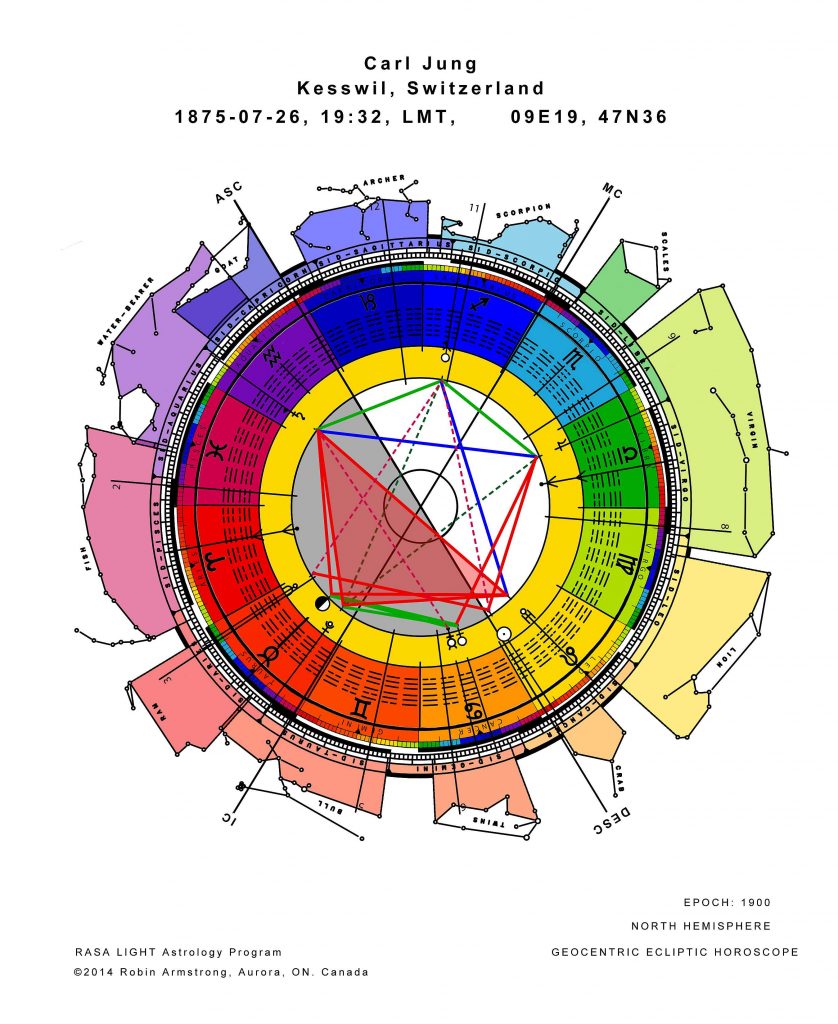
CARL JUNG’s EXAMPLE:
Carl Jung’s Sun: 3° Leo 19’
FOR EVERY POINT IN THE ZODIAC, OR POSITION IN A CIRCLE THERE WILL BE:
- 3 Signs…. A main Zodiac sign, a Pentan and a Sub-Pentan sign.
- 3 Hexagrams ….. There will also be three hexagram accentuations.


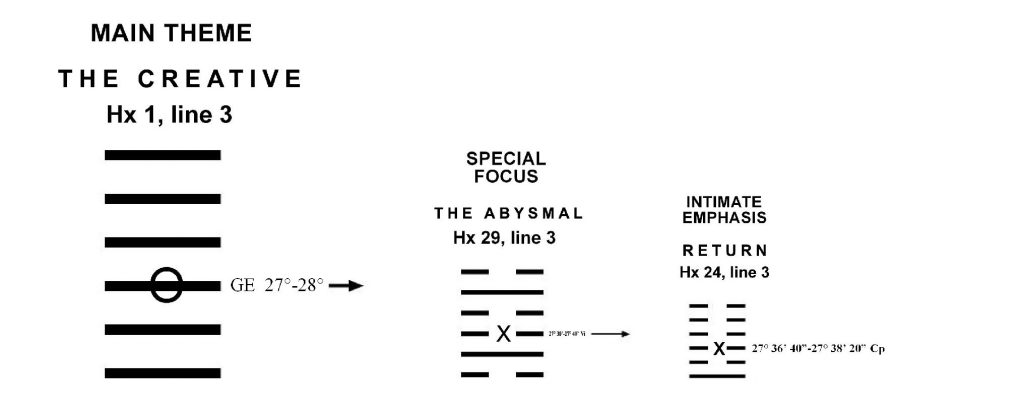
READING THE ASTROLOGY-I CHING PRINTOUTS
At this point you should have a copy of the I Ching Study Guide or you can order it it from the website: www.iastrostore.com . The next few pages will describe how to read the printout. Always remember that there are 3 signs (with Pentans) and 3 hexagrams for any position in the zodiac.
On the printouts, there are three systems of information. One is for the Heliocentric horoscope, the second is the traditional ecliptic based zodiac, and the third is for the Equatorial system (Right Ascension). The system we will be using will be in Bold type. There is no immediate need to concern yourself with the other systems until you are ready for them. Of course, the Hexagrams will be slightly different in each system.
Another distinction is that we are using the meaning of each planet as the question for the I Ching. Each planet has a specific meaning and set of concerns that will be elaborated on by the Hexagrams that it is in. To the degree that you understand the planetary implications, to that degree you will find new horizons of understanding unfolding for you.
There are places on the web that you can get a chart for free. www.astro.com/swisseph is one such source.
The beauty of this Astro-I Ching study guide is that it does present a well ordered access to all of the corresponding I Ching hexagrams.
Horoscope Data Printout for Carl Jung
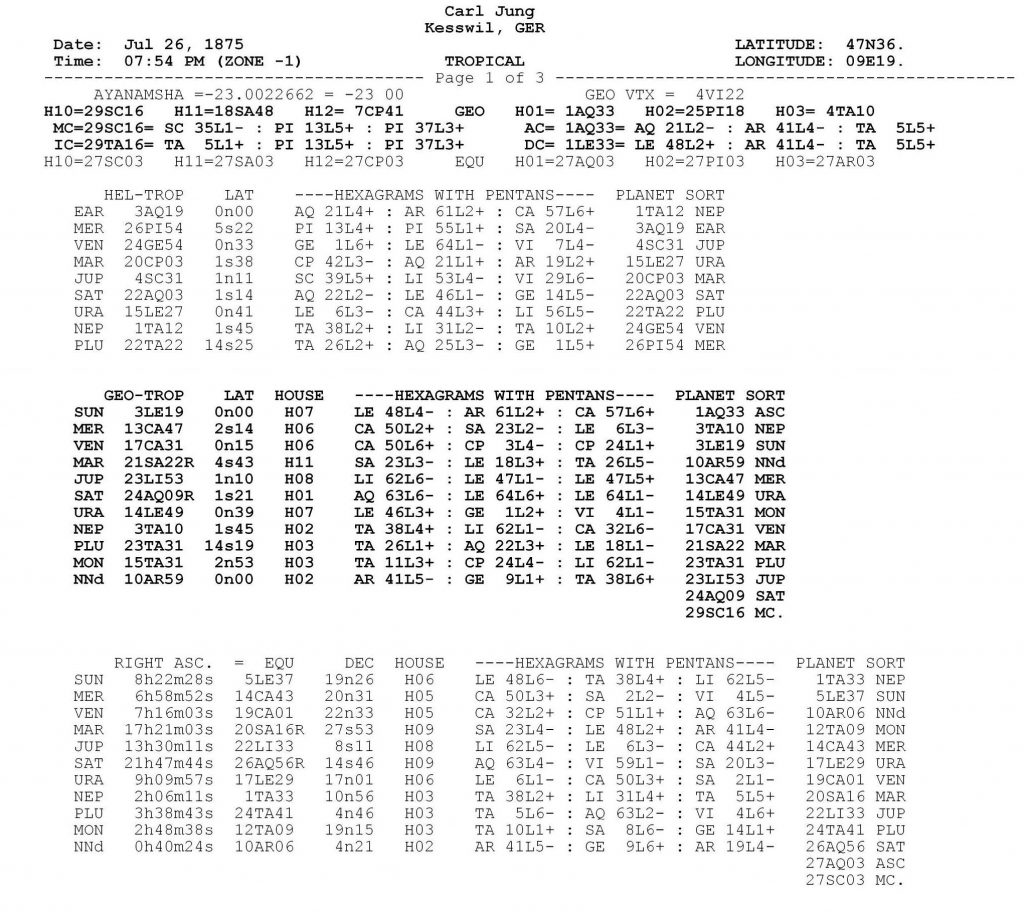
This is the main first page printout. It gives the planetary positions in three systems: Heliocentric, Geocentric (Ecliptic) and Right Ascension (Equatorial). The bolded type is for the Geocentric system which we will be using.

This is a copy of the top of the page. The birth data is on top and three of the last five lines are bolded. These three lines give the information about the astrological house cusps and angles (Asc., M.C., Desc., MC)

The red line above shows the actual positions of the house cusps. It only shows 6 positions because the other six houses are simply the same position but the opposite sign.

Here we see the degree position of the MC or tenth house cusp. It is 29° Scorpio 16’. Following this position are listed the Zodiac Sign of Scorpio and Main Theme hexagram #35, line 1. Then come the Pentan sign of Pisces and the Special Focus hexagram #13, line 5. Then comes the Sub-Pentan sign of Pisces and the Intimate Emphasis hexagram #37, line 3.

The Main Theme hexagram is 35. Progress, line 1(- means it is a broken or passive line). The Special Focus Hexagram is Fellowship With Men, line 5 (+ means it is a solid or active line). The Intimate Emphasis hexagram is 37. The Family, line 3(+ means it is a solid or active line).
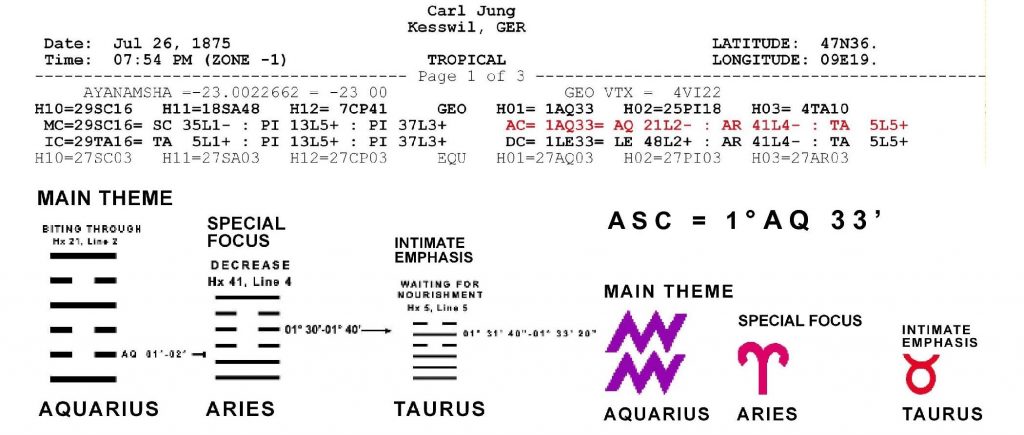
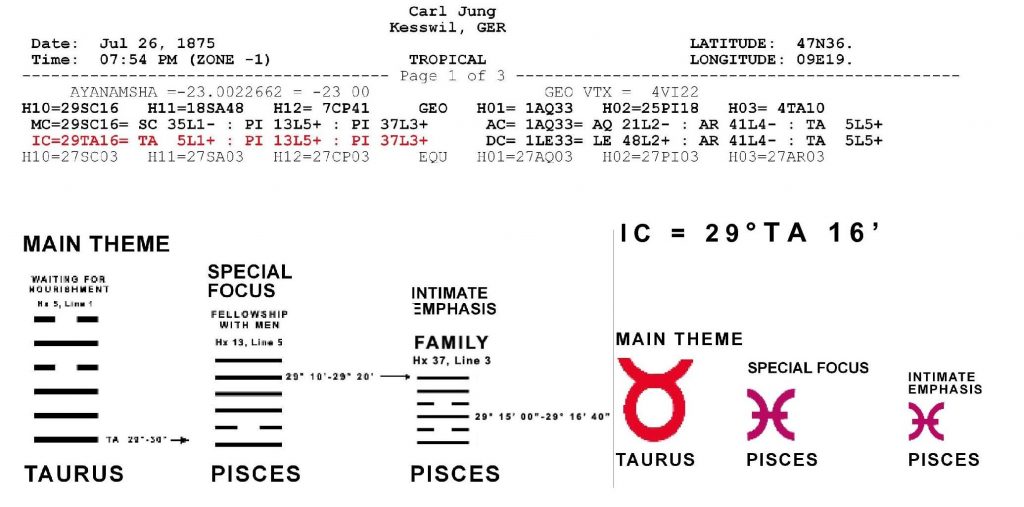
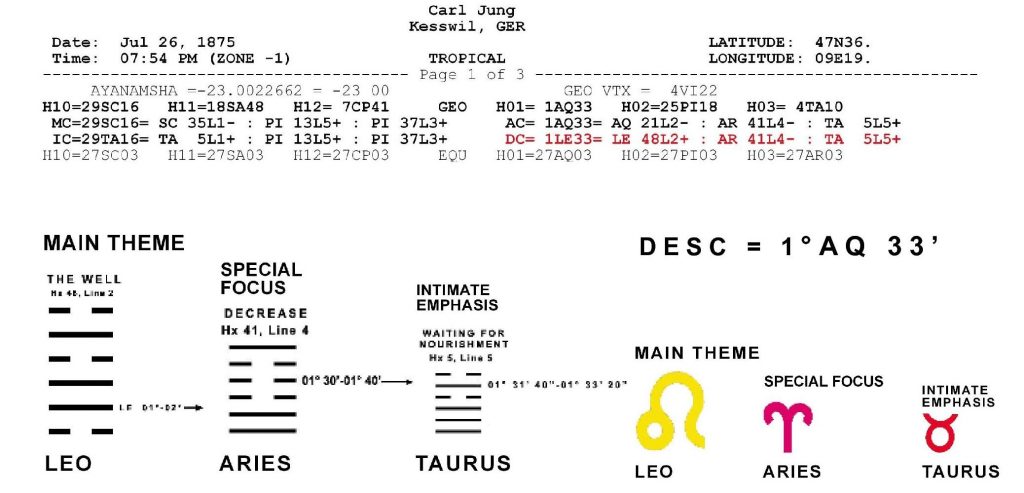
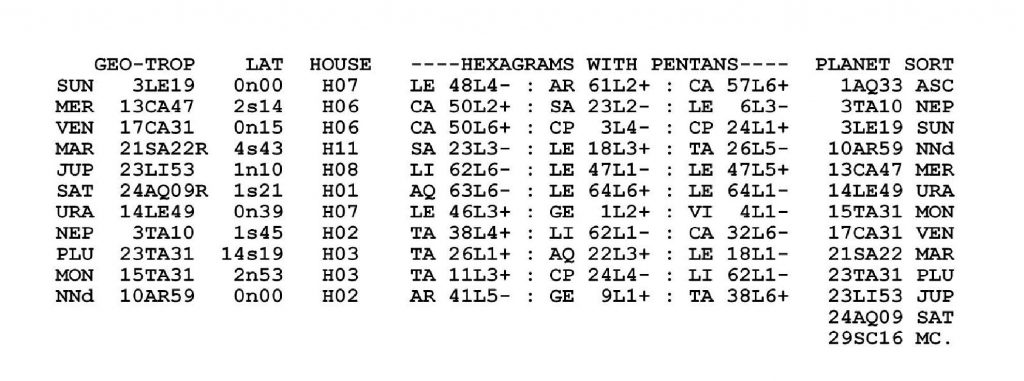
In the middle of the Natal Chart printout you will see the above section in Bold type. This is the section we will use. It tells us where the planets are in the Tropical Zodiac (Ecliptic based position).
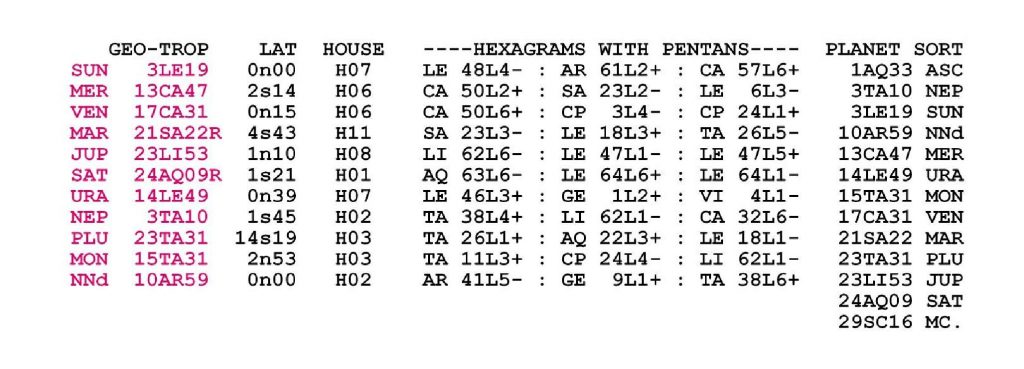
In red the planet names are listed with the appropriate Zodiac positions beside them. It is a three letter code for each planet and the last one NNd is for the North Node of the Moon.
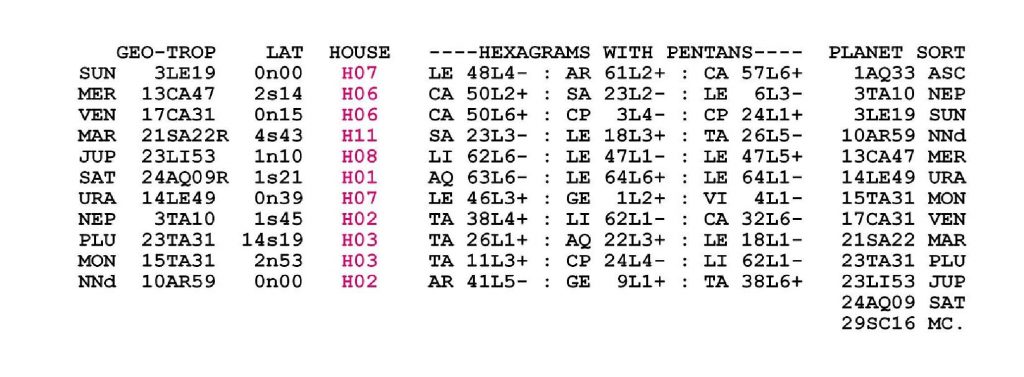
In this (the red) column the house position of each planet is listed.
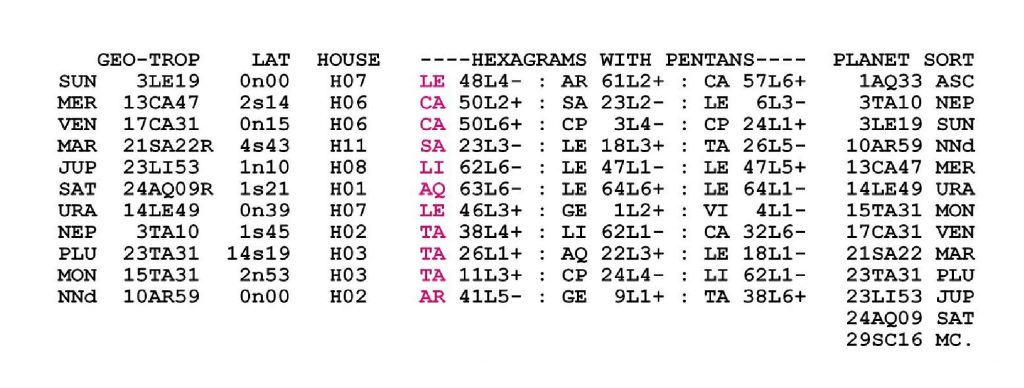
In this (the red) column the main or basic Zodiac sign of each planet is listed. (CA is used for Cancer and CP is used for Capricorn.)
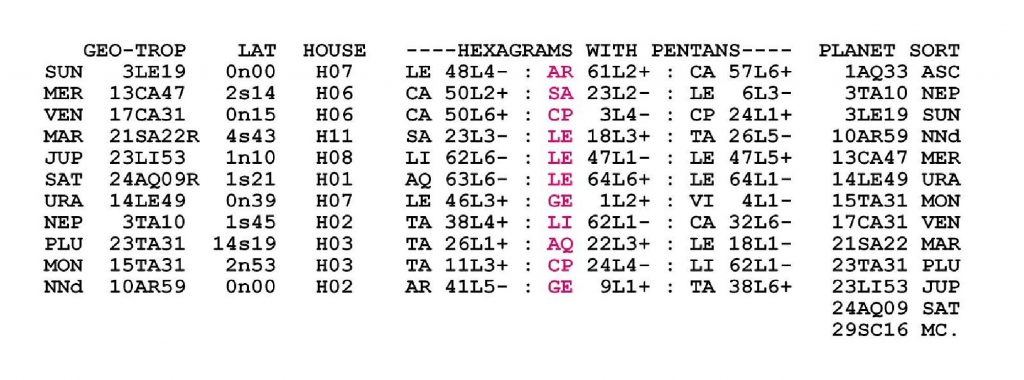
In this (the red) column the Pentan sign of each planet is listed.
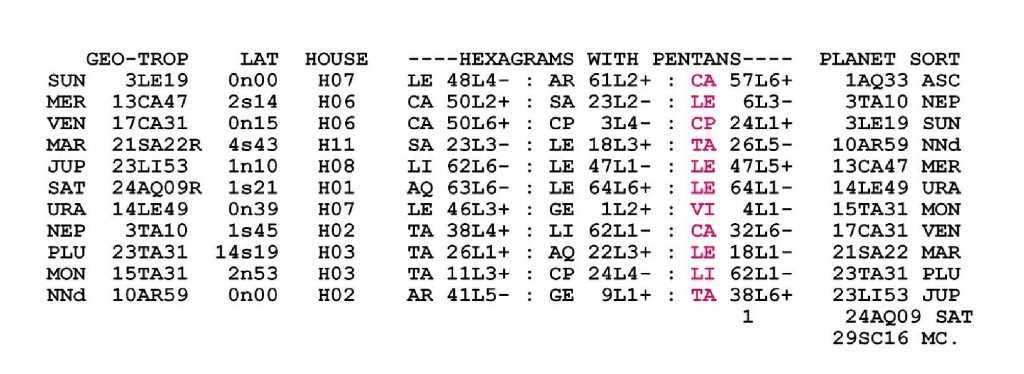
In this (the red) column the Sub-Pentan sign of each planet is listed.
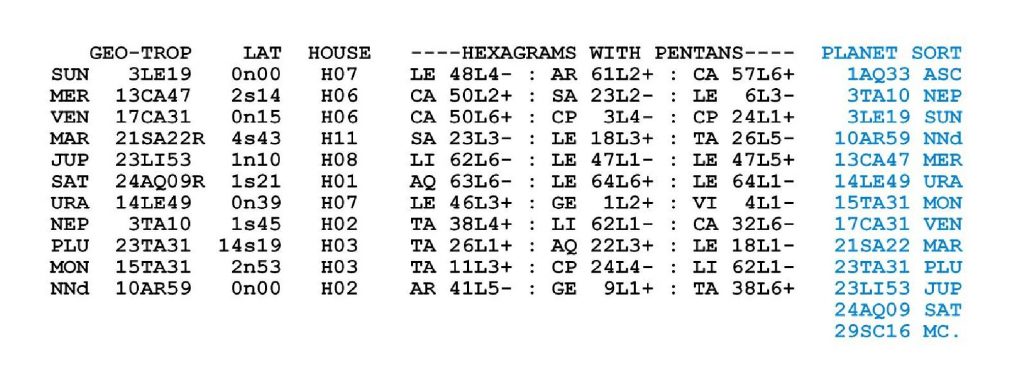
In this column (blue) the planets are arranged by their sequence from zero to thirty degrees. This was included as an aid for working with transits. We will not be using this information right now.
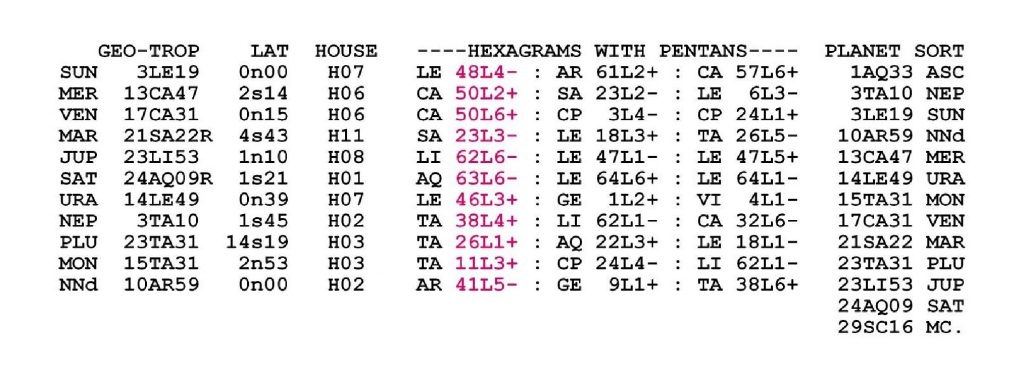
In this (the red) column the Main Theme Hexagram of each planet is listed. There will be a hexagram number , for example 48. The L4 tells you that the Sun is in Line 4 of Hexagram 48. The – symbol simply tells us that this is a broken or passive line. The + symbol simply tells us that this is a solid or active line.
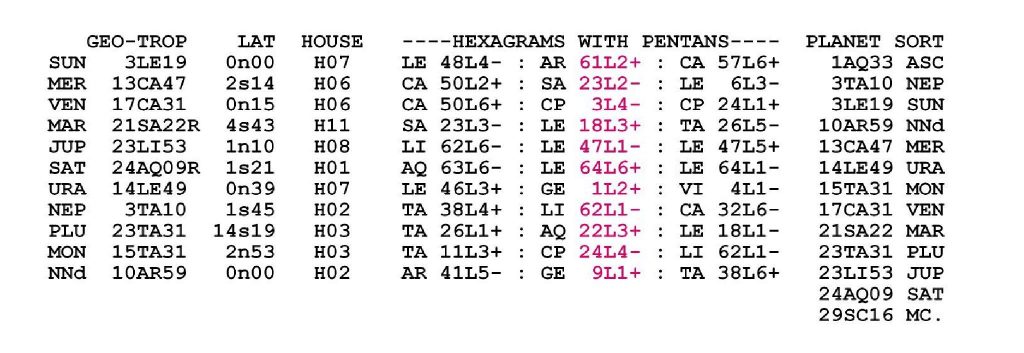
In this (the red) column the Special Focus Hexagram of each planet is listed. There will be a hexagram number , for example 61. The L2 tells you that the Sun is in Line 2 of Hexagram 61. The + symbol simply tells us that this is a solid or active line.
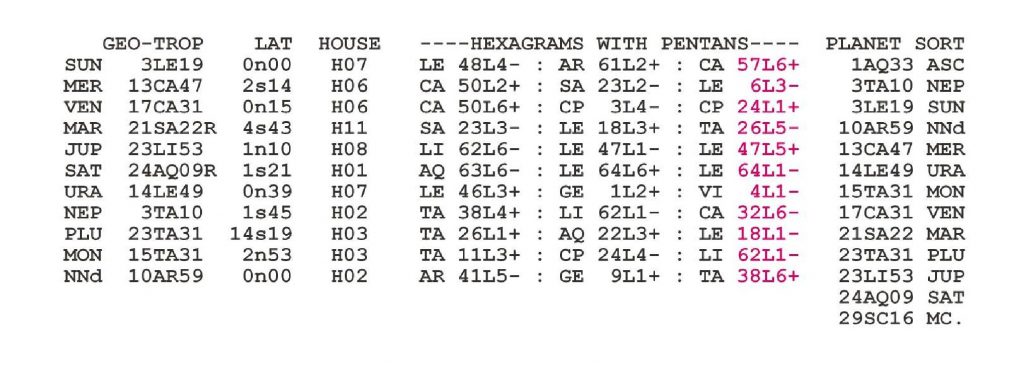
In this (the red) column the Intimate Emphasis Hexagram of each planet is listed. There will be a hexagram number , for example 57. The L6 tells you that the Sun is in Line 6 of Hexagram 57. The + symbol simply tells us that this is a solid or active line.
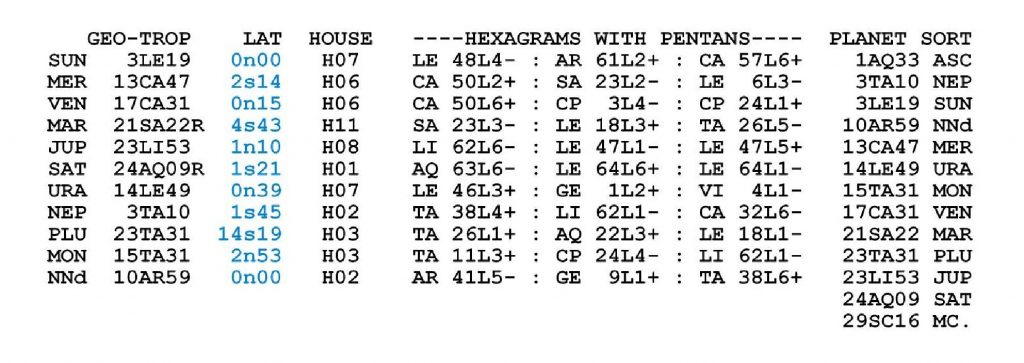
In this (the blue) column the Latitude of each planet, above (N) or below (S) the orbital plane of the Ecliptic, is listed.
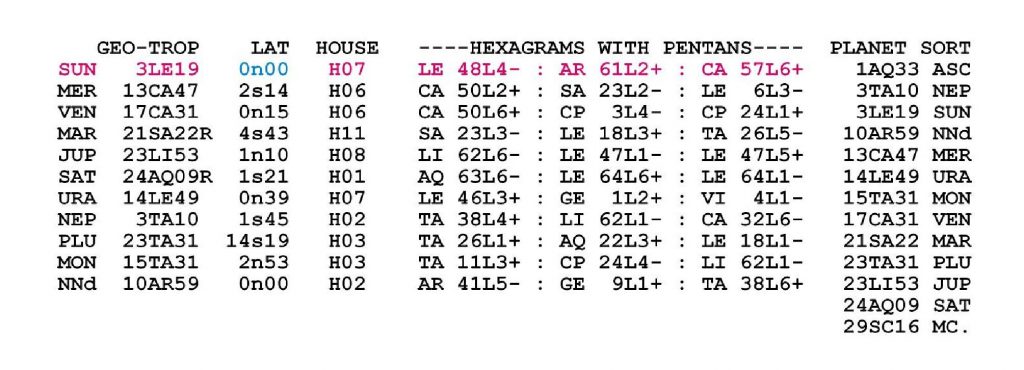

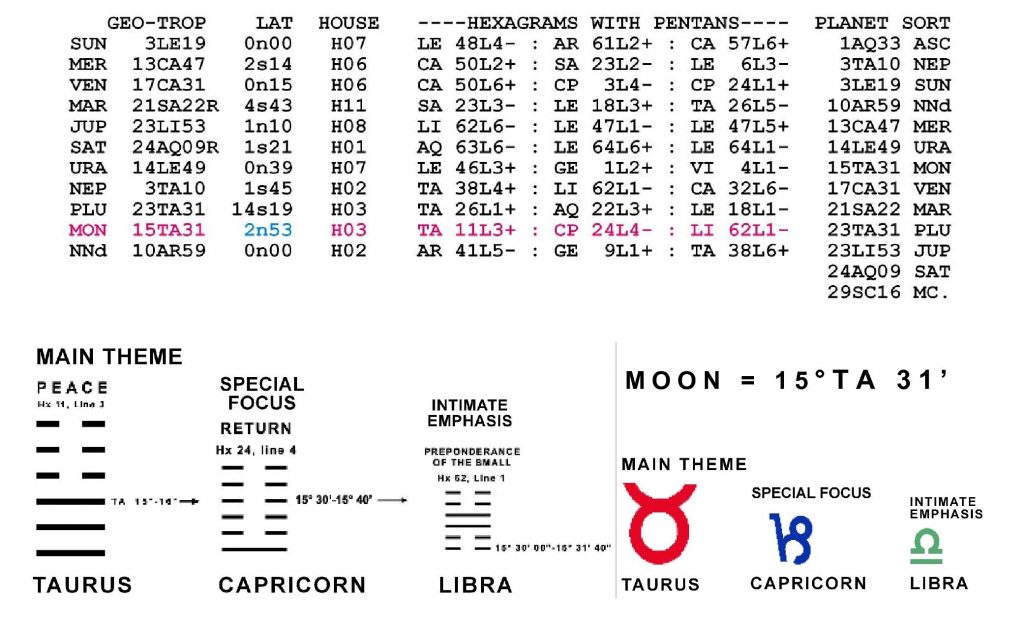
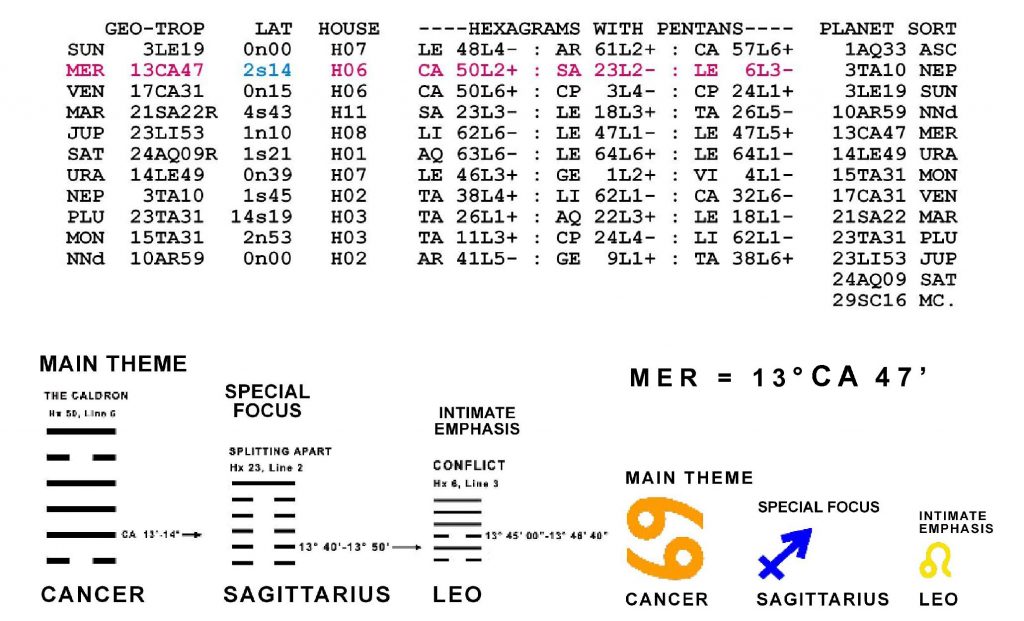

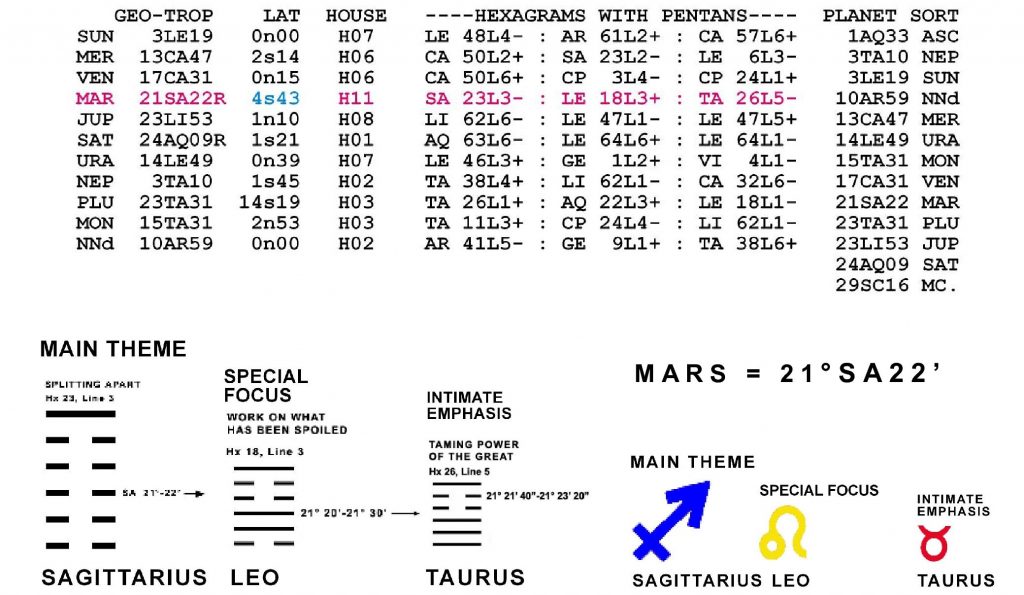
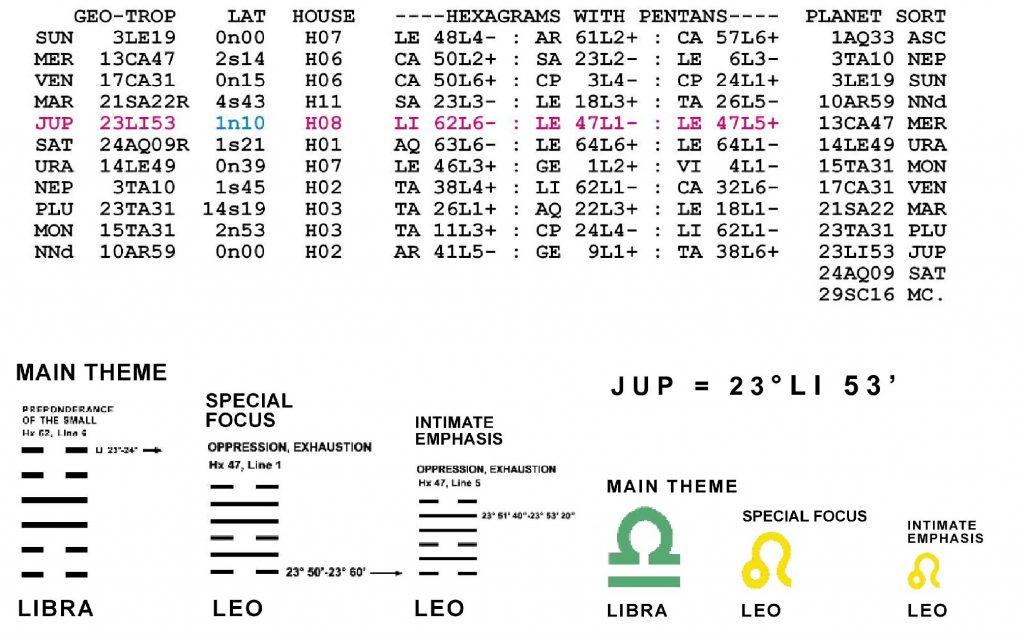
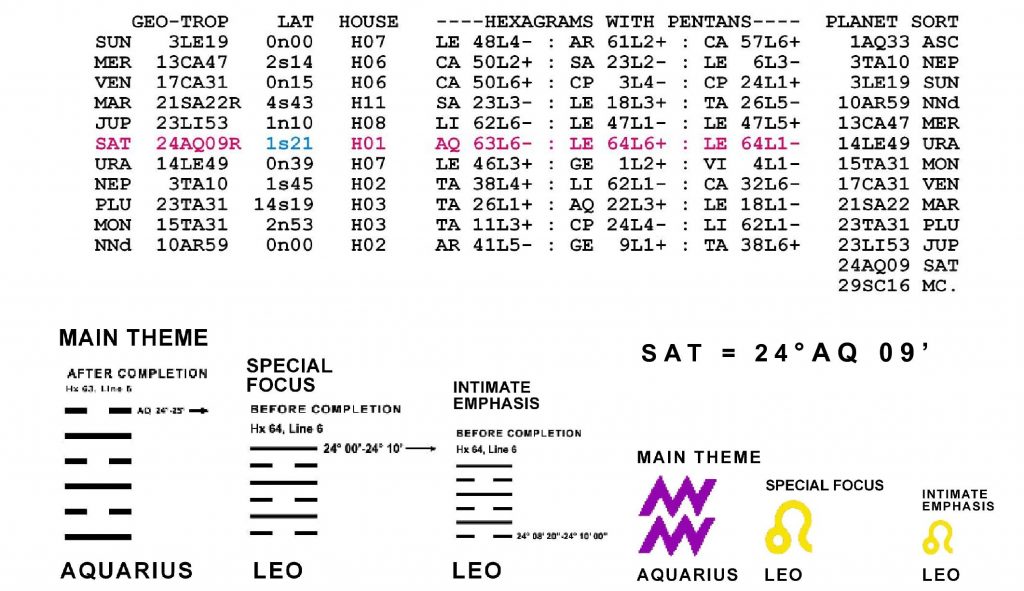
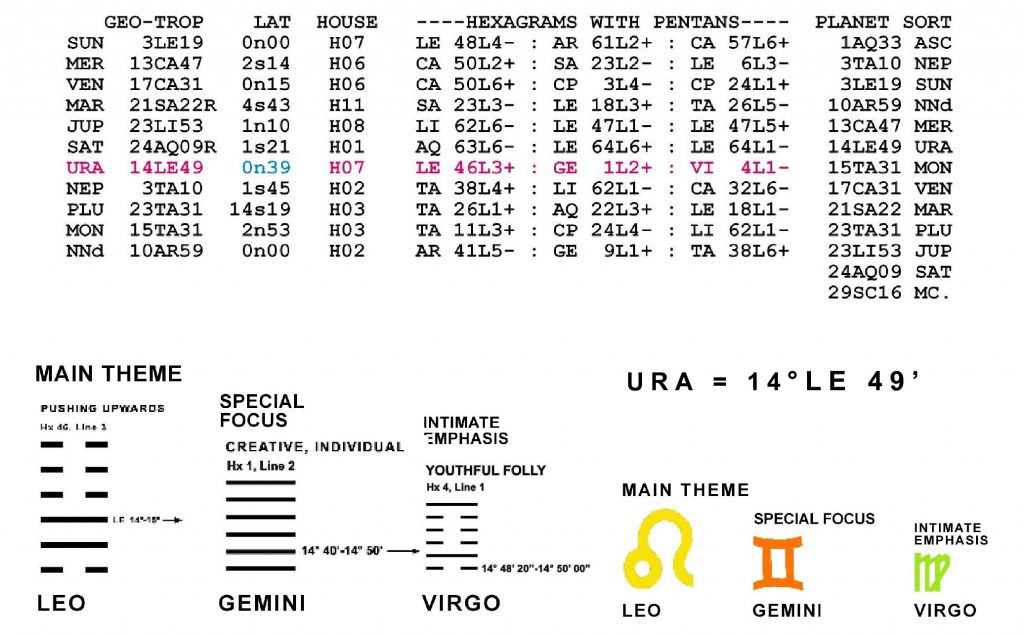
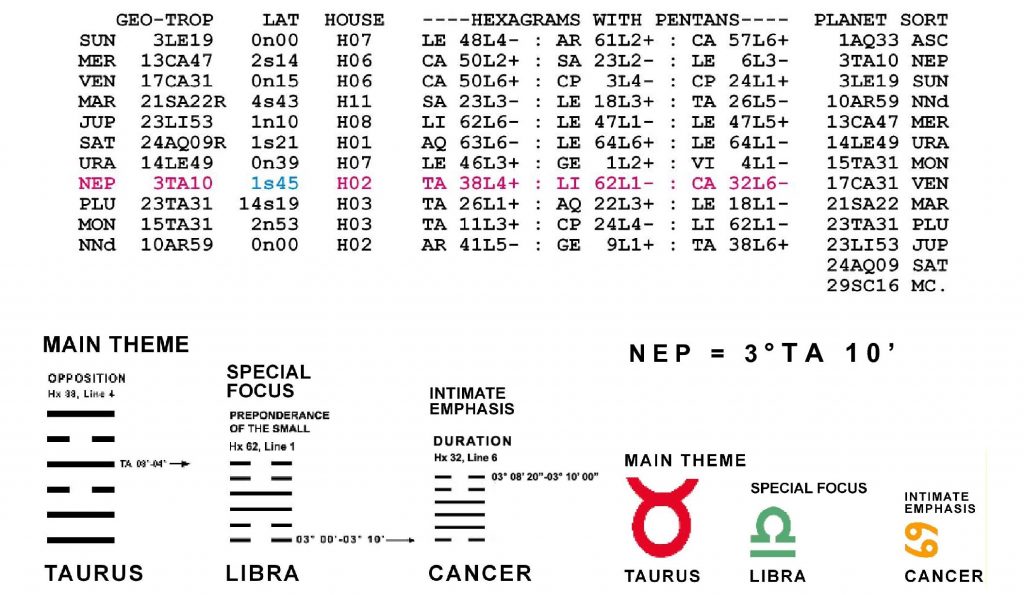
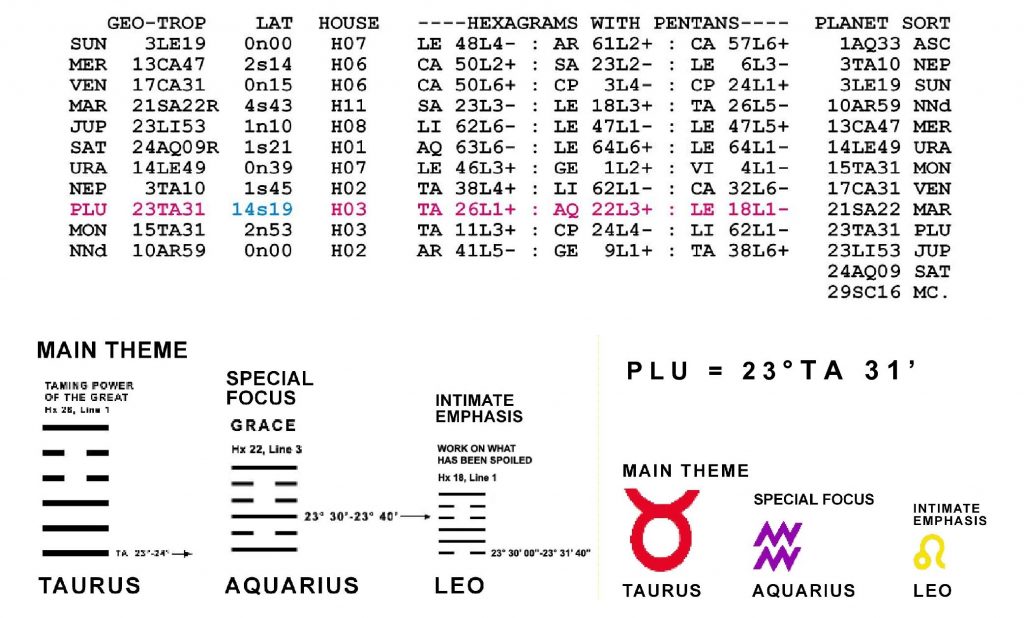
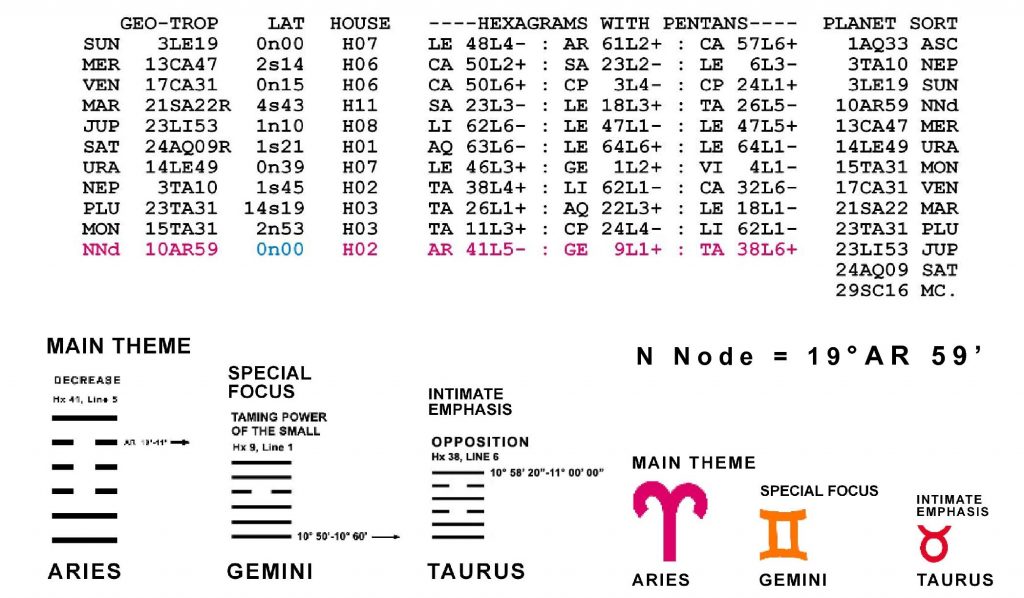
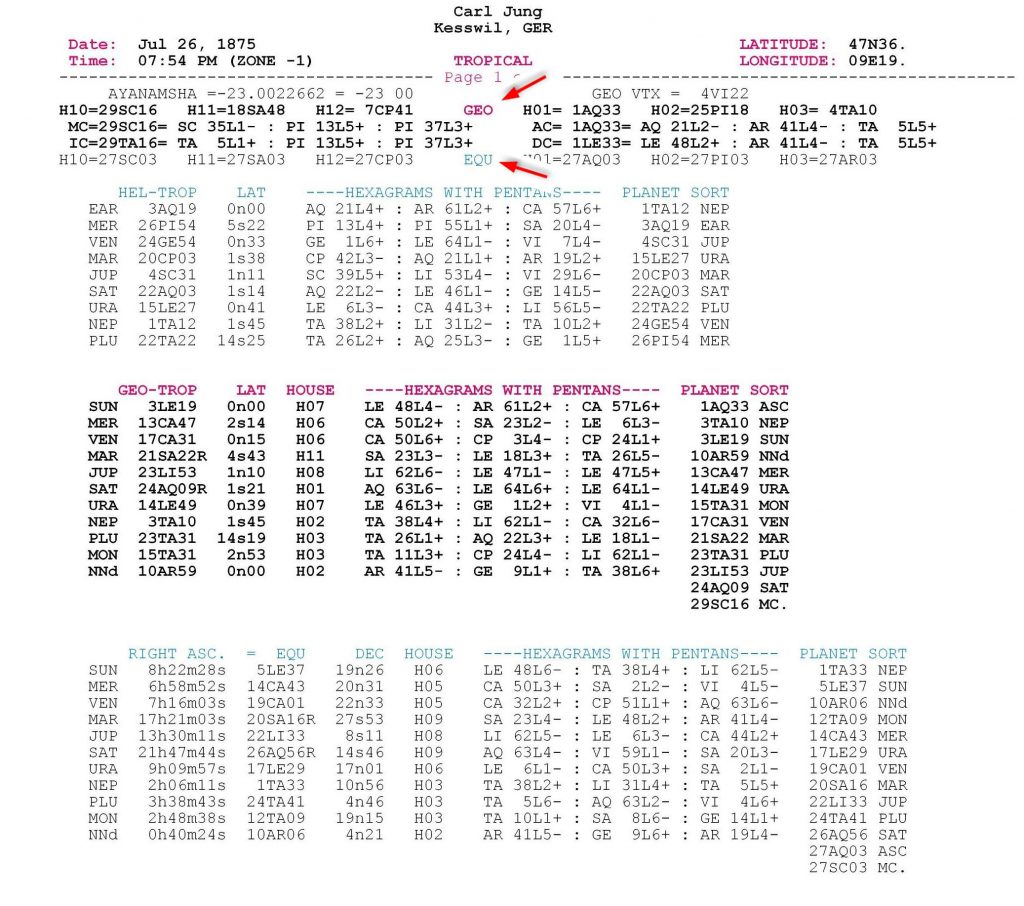
This page is simply highlighting the titles or headings for each section. You will notice at the top, under the GEO House positions that there is a Blue heading EQU. This is for the House position for the Equatorial System at the bottom. In this article we will simply be working with the Geocentric Tropical System (Red headings).
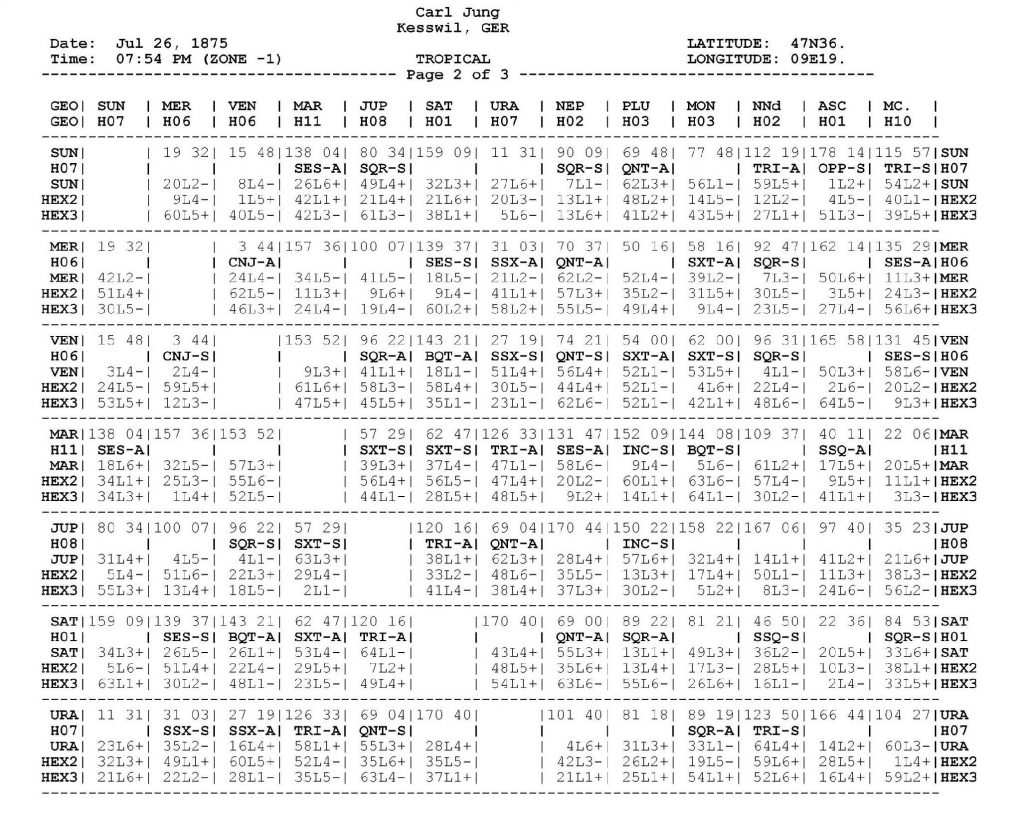
This is part one of the Aspect grid. Because of the extra information the printout is divided into two pages.
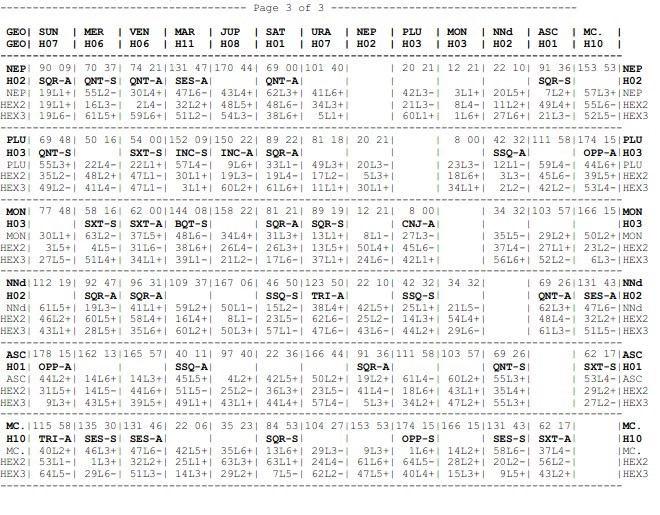
This is part two of the Aspect grid.

This segment of the Aspect grid shows the aspects of the Sun to all the other planets and positions. Underneath each planet name is the House that the planet is in.

The numbers in red tells us the exact aspect (in degrees and minutes) of the Sun to all the other planets and positions. Underneath the red column Bold letters will be shown telling you when there is an aspect and the aspect is followed by an A or an S to show whether the aspect is Applying or Separating.

The red numbers tell you the Main Theme Hexagram that applies to this aspect or relationship.
It is worth noting that in this system every degree of aspect relationship is unique. There are no meaningless or void-of course aspects. There is always something valid happening . The hexagram and line indicated will elaborate the meaning of that relationship.

The red numbers tell you the Special Focus Hexagram that applies to this aspect or relationship.

The red numbers tell you the Intimate Emphasis Hexagram that applies to this aspect or relationship.

In this example we see a red square revealing all the data about the aspect or relationship of the Sun to Mars. The first line in blue shows the aspect 138°04’. The second line in red tells us that this is a Sesqui-quadrate aspect and that it is applying or becoming more exact.
The next line tells us that the Main Theme hexagram is Hexagram 26 in Line 6 and that it is a solid or active line. Hexagram 26 is called “The Taming Power of the Great”. The next line in Green tells us that the Special Focus Hexagram is Hexagram 42-Line 1, another solid or active line. This is the Hexagram called “Increase. The last line in Orange tells us that the Intimate Emphasis hexagram is also 42 but Line 3 which is a broken or passive line.
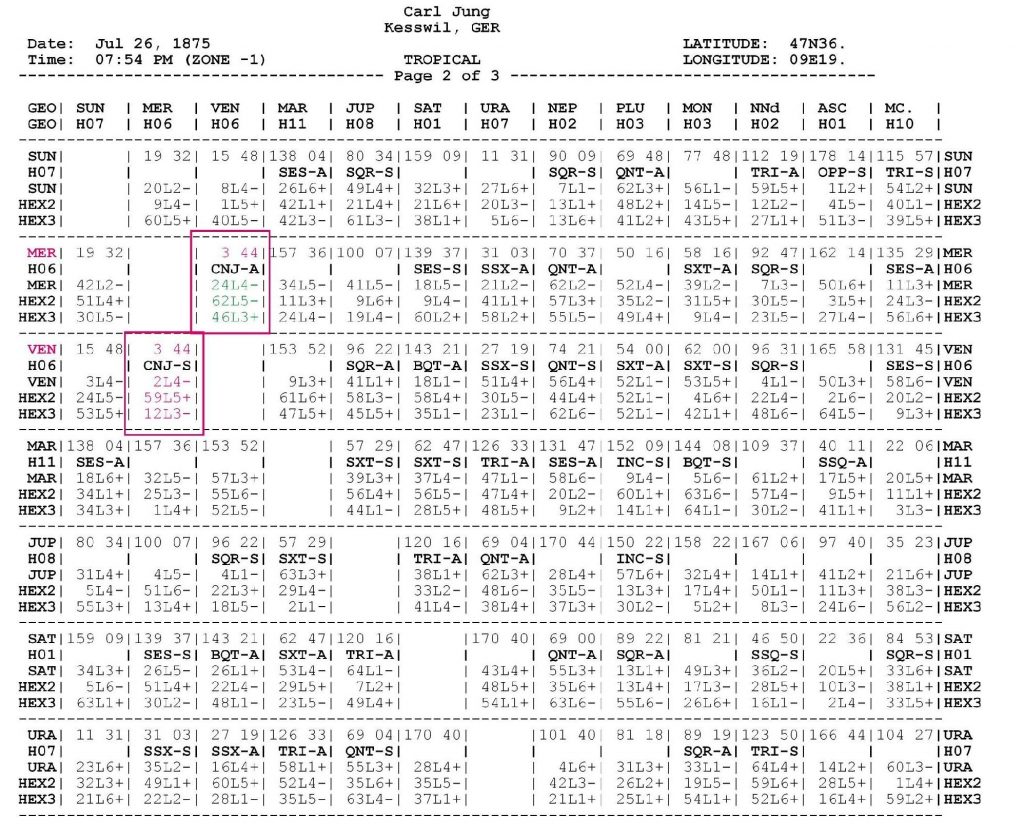
It is important to note that the Aspects should be read from the left to the right across the page. To read the aspect downwards would give wrong hexagrams!
Please note that in the red squares marked above that the aspect of Mercury to Venus is highlighted and so is the aspect from Venus to Mercury. They are both 3°44’ apart, but the hexagrams are different! This is because Mercury is 3°44’ before Venus and Venus is 356° 16’ before Mercury in the Zodiac.
The hexagrams take into consideration the full 360°00’ cycle of aspect relationships and every distinction is relevant.
This adds tremendous depth to aspect analysis and increases the amount of time one can spend studying the implications of change and relationship.
THE NATAL HEXAGRAM TOTALS OF CARL JUNG

This last printout shows the natal hexagram totals of Carl Jung Every hexagram accentuation from the Sun, Moon, planets and angles in the horoscope are totaled on all three levels. The results, printed above, tell you how many times each line of every hexagram is accentuated
This form has been divided into two sections as it is large and prints out in a landscape format (11×8.5) rather than in the usual typing page format.
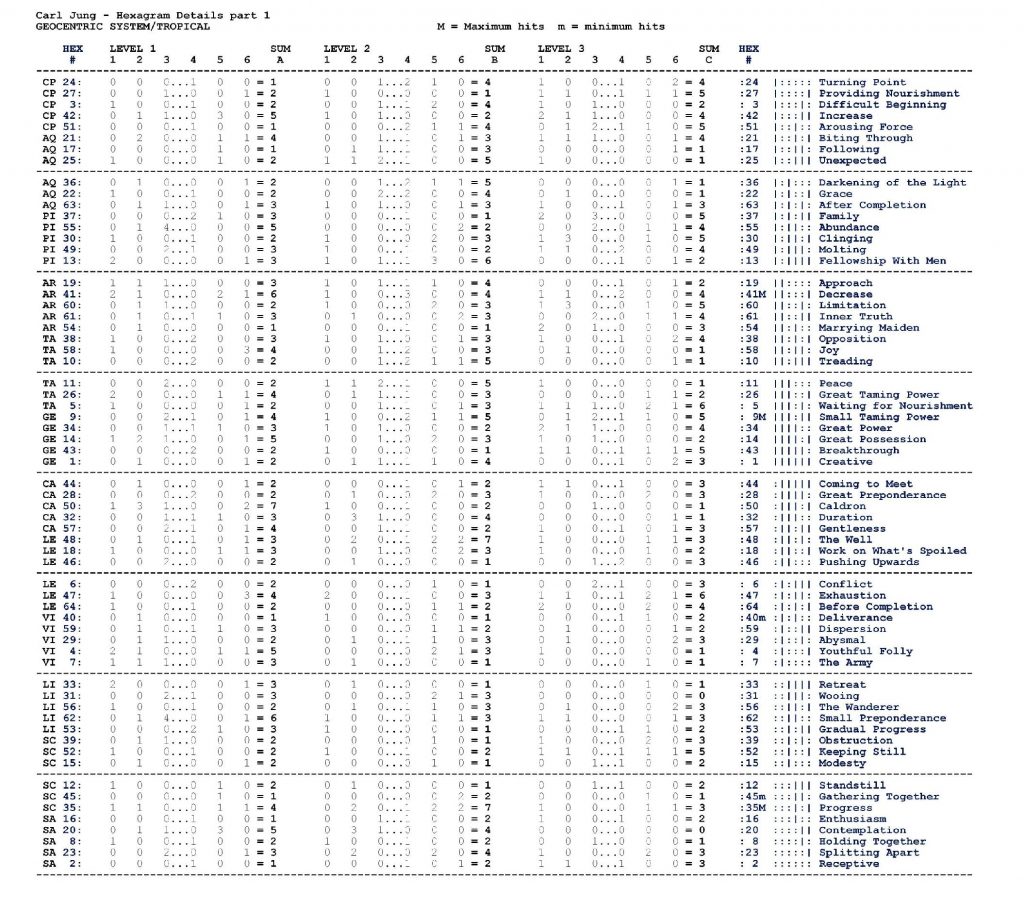
The first column on the left hand side, in black, shows the sign of the Zodiac, and beside it in dark blue is the corresponding hexagram number. On the right hand side you will see the same hexagram number, with the hexagram printed out on its side, and then the name of the hexagram beside that.
This helps in navigating the data. It lets you relate to which hexagram is being referred to without having to look it up.
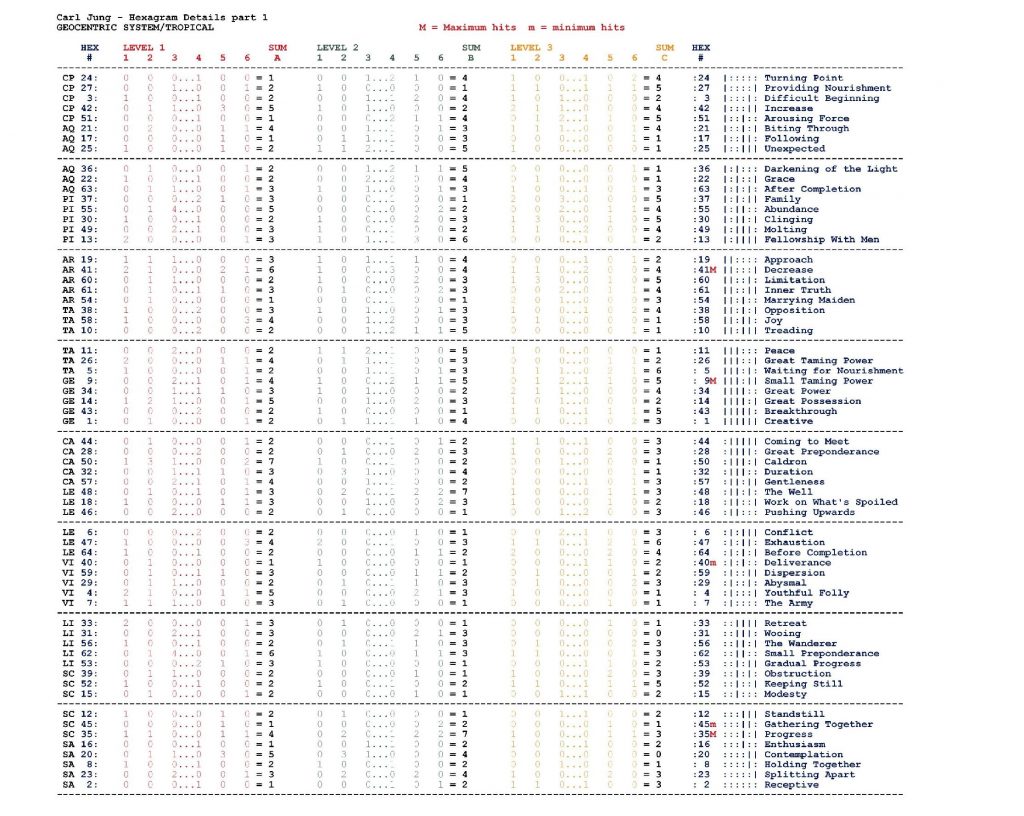
There are three main sections to this page, one for each hexagram level. The first set of data for the level one or Main Theme hexagram is highlighted in RED. At the top in the heading you will see Level 1 and under it the numbers 1 to 6 followed by the words SUM A. Each number stands for the corresponding line of a hexagram. We can see here how many times each line has been accentuated on the first level (Main Theme). Just to the right of these six column is a column in bolded black that shows = and then a number. This number tells you the total number of times on that level that the hexagram was accentuated.
The next six lines in Green do the same for level two or Special Focus Hexagrams.
The following six lines or columns in Amber show the totals for level three or Intimate Emphasis Hexagrams.
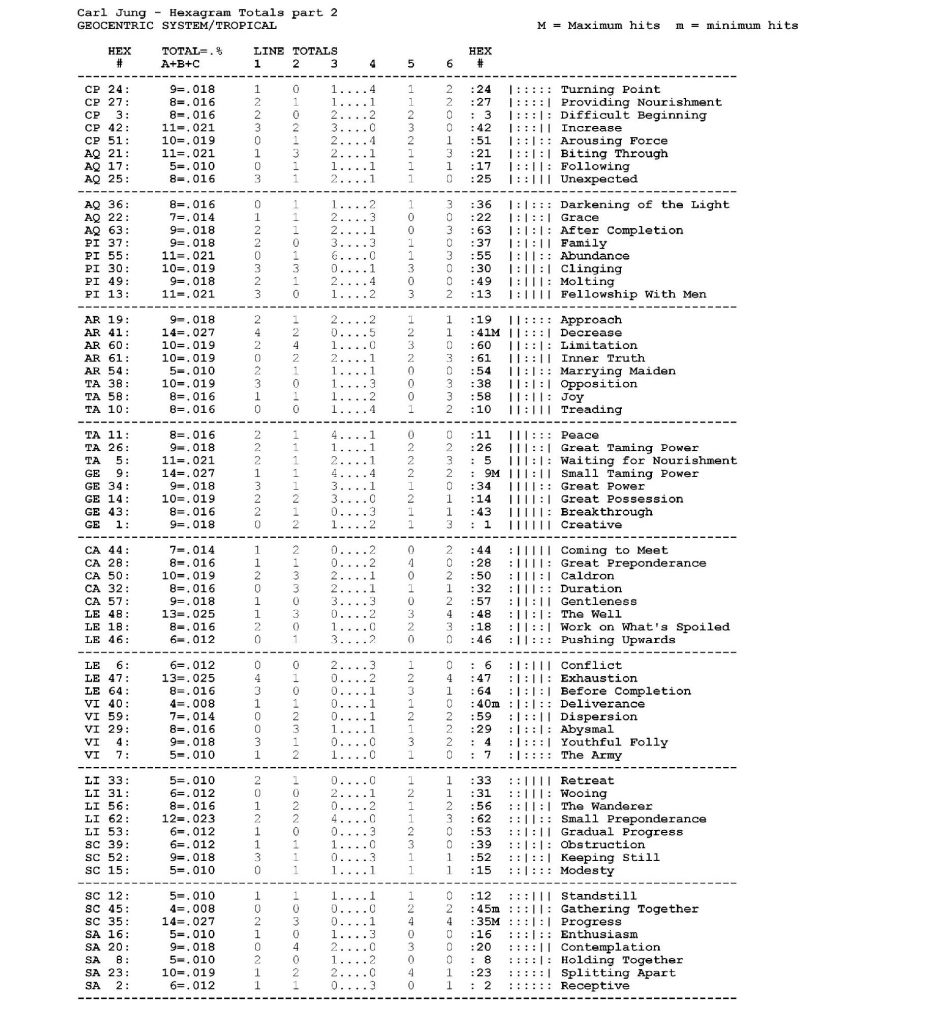
This page is from the right hand side of the printout. It shows the total number of hexagram accentuations from all three levels added together. This would tell Carl Jung any time he used the I Ching what his natal predisposition to each hexagram was. This gives us a quantitative value of how important each line of any hexagram is to the person concerned, in this case to Carl Jung. This gives a very unique way of weighting the Zodiac and its degrees to each individual.
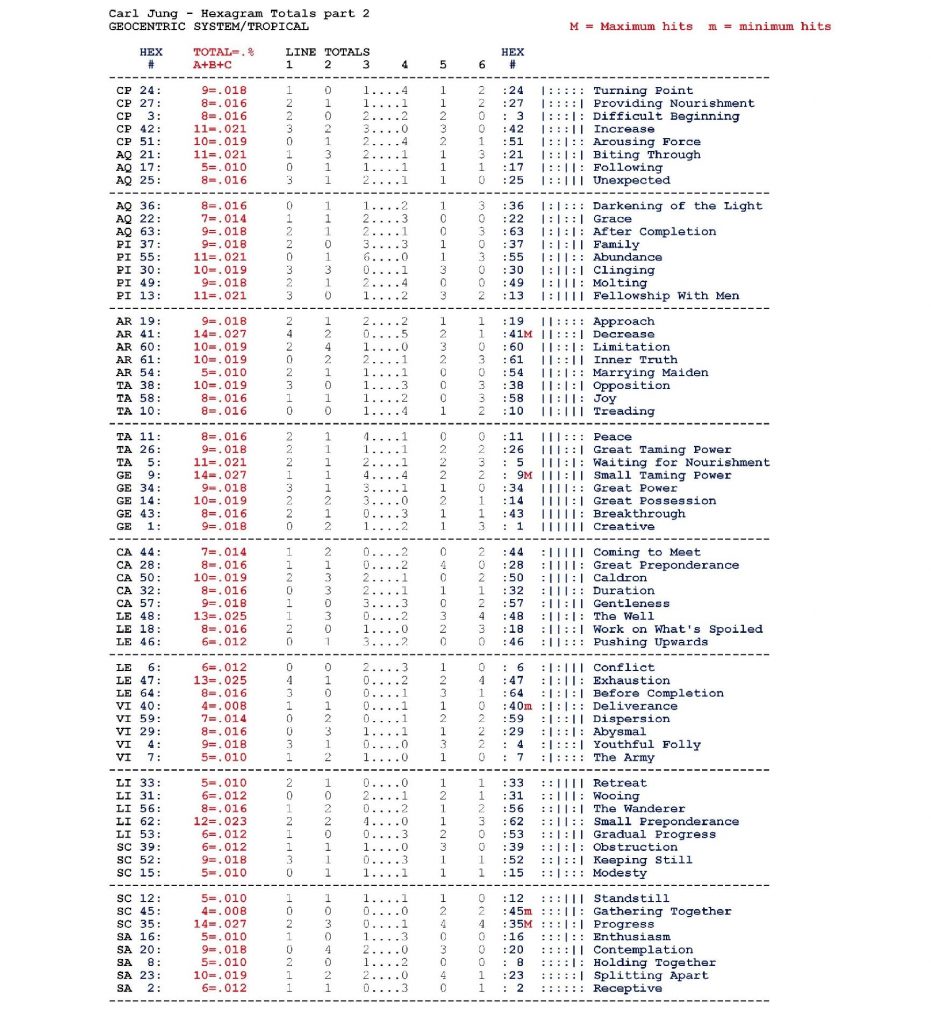
The column in red shows the total number of times each hexagram is accentuated and beside the = sign is a decimal number that represents the percentage of the total astrological hits possible. .018 would be the same as 1.8%.
On the right hand side beside the hexagram numbers you will notice a few letter Ms and letter ms in Bold Red. These are telling you which hexagrams are the maximum (M) and minimum (m) of those accentuated. This reveals the hexagrams or relationship themes most and least familiar in that person’s life!
